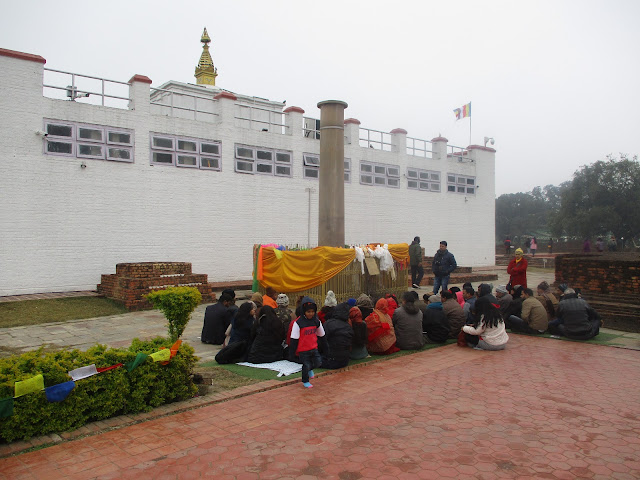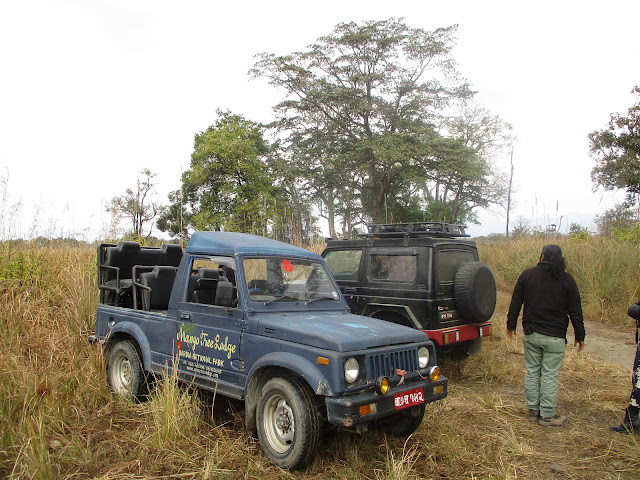Birthplace of Buddha and a Fierce Bengal Tiger Attack
 |
| One of the of ~3500 or so one horned Himalayan Rhinos still around on Planet Earth. This one is in captivity for its own safety at Bardia National Park and he does not appear very happy about it. |
On our way to a safari, our first stop was to Lumbini Nepal, the supposed birthplace of one Siddhartha Gautama, who became a buddha (teacher) and went on later to become THE Buddha. Our introduction to the Buddha's birthplace was kinda of underwhelming. This is where the bus from Polkara dropped us off. The religious park is a gigantic affair to the left behind those trees. They say that they are working on paving the road, but still...
Water supply and dishwashing area at a restaurant in Lumbini. Afterall, we are on the border of India.
Entering the monastery complex. Translation below:
The five precepts of Buddhism's morality system for lay people. Gentle reader, how many do you observe?
If some of these concepts look familiar to Christianity's Ten Commandments it is because some scholars espouse the controversial belief that Jesus studied the Vedas and Buddhist concepts in India and Tibet. There is the period of Jesus' life, known as the Missing Years, that is not mentioned in the New Testament. Nothing is known about what Jesus was doing from the age of 12 to 29. Some scholars say he was in India, others Britain or Egypt and others say he was a carpenter working with Joseph in Galilee. Still others say we just don't know what he was up to, but the concepts of the two religions sure are similar.
The whole town of Lumbini caters to pilgrims of several religions as well as the curious.There are many old and new monuments and temples. Modern monasteries from many countries are completed or under construction.
The Puskarini, or Holy Pond where Queen Mahamayadevi had her ritual bath before giving birth to Prince Siddhartha and where the infant prince had his first purification bath. |
| Pilgrims listen to dharma in front of the Pillar of Ashoka. The white building protects the ancient ruins of the Maya Devi temple. |
Ok folks, this is where it gets a little complicated, but don't panic as you have Chef Ted to break it down for you.
One King Ashoka inherited the Mauryan empire from his grandfather in 268 BC. He was a ruthless dictator that had a change of heart after murdering thousands of people and converted to Buddhism (Buddha was born in ~563 BC). He was known for establishing a series of columns inscribed with with edicts throughout India. These edicts included Buddhist concepts, messages to monks and nuns and commemorations of his visits to various sites.
In 1896 archaeologists discovered the Pillar of Ashoka (above) near what is now Lumbini. The inscriptions on the pillar state Ashoka's view that this was indeed the birthplace of the Buddha.
Rupandehi, as Lumbini was known then, had been a religious site long before Ashoka visited some ~300 years after the birth of Buddha.
What you need to know: If the Pillar of Ashoka says the Buddha was born here, you better bloody well believe it or suffer the consequences. King Ashoka took his edicts seriously and evidently the man don't play.
The Bodhi tree is a type of fig tree that Buddha meditated under and reportedly reached enlightenment (bodhi) in the town of Bodh Gaya. Many trees around India are cited as being propagated from that aboriginal tree. These propagations are moved and transplanted and thus become tree shrines all over the area. This one, near the temple ruins, stupas, pillar and pond, has purportedly been here since ancient times.
You had to take your shoes off to enter the area. After about an hour of wandering around our feet started to turn blue so we called it a day.
Jaime and Bijen are planning a trip in March for ~30 high school students from the United Nations International School and wanted to check out the Mango Tree Lodge for suitability and we decided to tag along. They met us in Lumbini and we crossed into the Terai region of Nepal. The Terai is the southern Nepal/ northern India area that runs parallel to the outer foothills of the Himalaya. This lowland belt is characterized by grasslands, marshes, savannah, sal forests and clay rich swamps.This also means mosquitoes in the wet/hot seasons and possible malaria exposure.
The cabins are simple mud thatch and the local Nepali food awesome. Rajen said that Jane Goodall, Hillary Clinton, Prince Harry and other muckety mucks have visited the lodge located near the entrance to Bardia NP.
We were basically the only guests in the dead of winter, but man did we have an spectacular New Year's Eve with our host and talk storyman Rajen.Rajen regaled us with his stories of his life's work as a guide in both Chitwan NP and Bardia. I managed to make it until 11:30; I heard that the rave went on till 2:00 AM without me.
Walking around the village of Thakurdwara. Most of the villagers are ethnic Tharu, who were primarily jungle dwellers back in the day. In the 1950's the government successfully introduced anti-malaria programs which opened up the area for settlers.
You know what that means for the jungle dwellers.
Many Tharu still live in traditional log houses, have their own tribal Hindu religion, practice subsistence farming and animal husbandry.
I noticed a lot of mustard greens being grown; they eat the greens and use the seeds for seasoning and making mustard oil.
I also noticed that the women do all the heavy lifting in village life.
Never once saw a man hauling firewood or goat fodder on his head.Talk about small business! These one person little shops abound in Nepal. They usually sell snacks and paan, a betel nut, spice and tobacco mixture that they chew. Many of the homes sell a few things as well.
Headed out into the park early one morning for a large mammal safari (there is an actual word for this used by by tour operators in Africa: the big five ) with two guides.
The guides would have us sit quietly in various places for an hour or so.
We could hear elephants, but nothing came out of the jungle to drink from the river.
Did you see anything yet?
Lot of monkeys in a tree. Lots of spotted deer as well, which I suppose the tigers eat.
Tried this structure for a while. The tigers had clawed the trees, so they couldn't be far away.
Stayed on this tower for two hours and had fried rice and oranges for lunch. Another group later told us that the tigers appeared about an hour after we left. Remember the line in the movie Endless Summer when one surfer told another about the previous day's waves: "you shouda been here yesterday mate".
How do you tell the difference between elephant and rhinoceros dung? Rhinoceros feed in one area and poop in the same spot for ~three weeks and then leave when the food is depleted. Elephants continually graze and drop a load anywhere. Three weeks of rhinoceros droppings here, including a fresh one.
Alas sweet reader, the fierce tiger attack was thwarted, as the closest we got to any wild beasts was when we saw where they kept the park's working elephants at night. Whole adventure was a lotta fun though.
Thanks for stopping by

































Comments